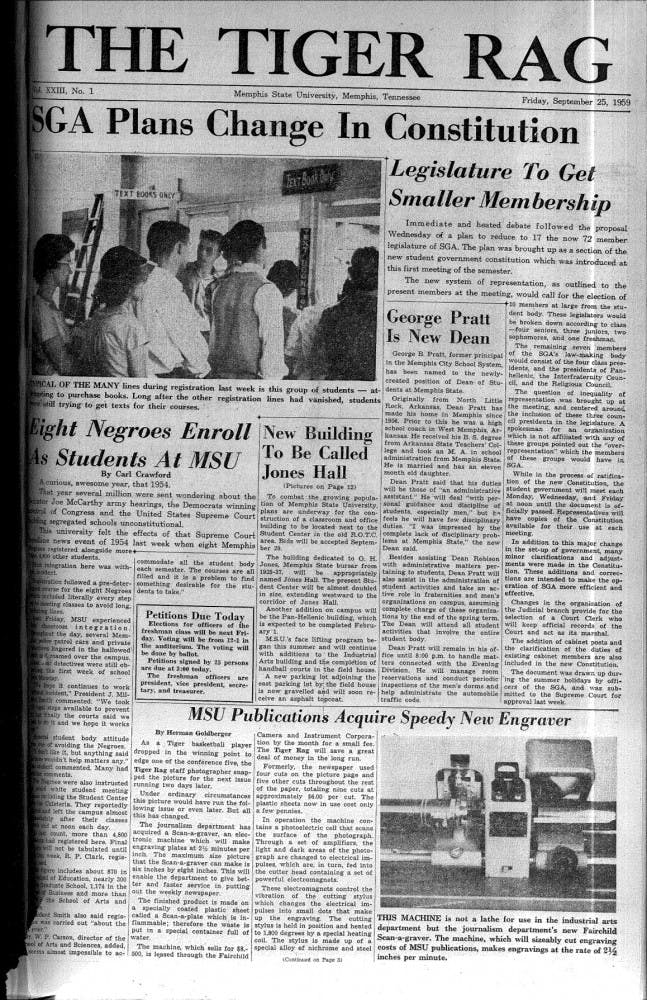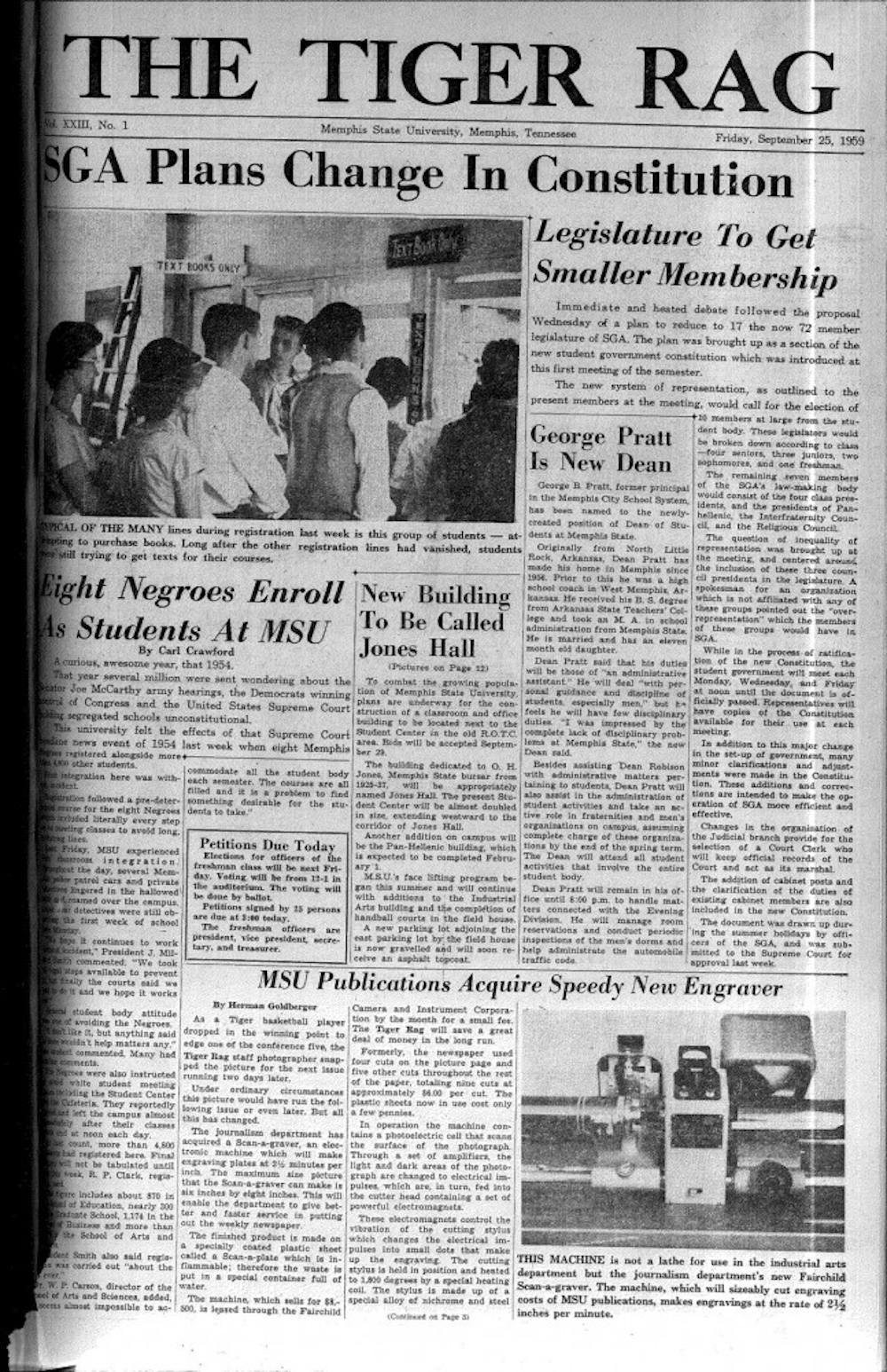
The predecessor of The Daily Helmsman, The Tiger Rag, covered the integration of the University of Memphis with just a brief story at the bottom left corner of the front page. Eight students enrolled at the university in the fall of 1959 and became the first black students at the university.
Eight African American students defied odds and shattered racial barriers when they set foot on the campus of Memphis State University in fall of 1959.
Luther McClellan, Marvis Kneeland Jones, Sammie Johnson, Ralph Prater, Eleanor Gandy, Rose Blakney Love, Bertha Rogers Looney and John Simpson were all part of the Memphis State Eight, the first group of black students to attend Memphis State.Â
The students’ high scores on their entrance exams caused Jesse H. Turner, Sr., a leader of the Memphis chapter of NAACP, to recruit them to Memphis State.
While each student had different lifestyles and backgrounds, they were prompted to enroll in the once racially divided university because of their finances, a need for higher education and the ongoing Civil Rights Movement.
Although they entered the school together, they did not take the same courses or have the same professors, which caused them to not see each other as often as they may have wanted.
“I couldn’t speak with the other seven because they didn’t have the same professors or subjects,†Marvis Kneeland Jones said during a WKNO interview in November 2006.
Aside from being separated from each other, some of the eight students said they also felt unwelcome by white students.
“I felt like I was invisible,†Sammie Johnson said during a 2006 WKNO interview. “The white students were unwelcoming, and it was clear that they weren’t excited we were there.â€
Ralph Prater said the uninviting behavior of some white students made him feel isolated.
“Students didn’t speak to me, and they wouldn’t sit by me in the classrooms — there would be vacant seats on both sides,†Prater said during the 2006 WKNO interview. “If I ever sat at a table with students, they would all leave.â€
Most of the eight students felt secluded from their white peers, but Luther McClellan described his experience as neutral during the 2006 WKNO interview.
McClellan said there were isolated incidents of racism, but the racial tension decreased as the years passed.
“The first year was tense, but each year got better,†McClellan said in the interview. “Each year, more black students were attending the university.â€
McClellan also said taking major classes with the same students caused him to develop casual friendships with them.
Many of the former students said they think the restrictions and the administrators’ attitudes and behaviors set the tone and created the tense atmosphere on campus.
During their orientation, the students said administrators informed them of their restrictions. They were not allowed to enroll in the ROTC or physical education classes, be on campus after noon, attend sporting events or enter the cafeteria or student center.
When the public started focusing less on the presence of the Memphis State Eight, and white students began to accept them, the restrictions were removed, and more black students were admitted to the university.
The arrival of the eight students paved the way for other African American students to come to the school.
This spring semester, about one-third of the 19,987 students enrolled at the U of M are black, according to the U of M Office of Institutional Research.
Aram Goudsouzian, U of M history professor and history department chair, said the Memphis State Eight continued the fight for equality of their time.
“After the Memphis State Eight, generations of African American students brought a genuine black presence to campus through organizations such as the Black Student Association,†Goudsouzian said. “Over decades, black students have struggled to make this campus a truly integrated place.â€
Linda G. Hall, U of M’s associate dean of multicultural affairs, said a lot of progress has been made since the fall of 1959.
“The number of African Americans that attend the university is very high, and there are key African American administrators, such as the Provost, Chief Legal Counsel, Dean of the College of Education and the Vice President of Student Affairs,†Hall said. “African American students have occupied the top positions in most of the prominent organizations on campus, including Student Government, Student Activities Council and Student Ambassador Board. There have been many programs and resources initiated to ensure the success of African American students.â€
Hall said she hopes current U of M students know of the sacrifices the Memphis State Eight made for it to be possible for them to attend the school and enjoy the freedoms they have today.Â
“I think students should be aware of the shoulders on which they stand, and they should work hard to be successful in and out of the classroom as a way to pay it forward,†Hall said.
Luther McClellan, Marvis Kneeland Jones, Ralph Prater, John Simpson and Bertha Rogers Looney are the five still living members of the Memphis State Eight.
Sammie Johnson died at age 71 on Jan. 15, 2011, in Grandview, Missouri, Eleanor Gandy died at age 76 on Feb. 6, 2017, in Charlotte, North Carolina, and Rose Blakney Love died at age 75 on Feb. 12, 2017, in Memphis.






